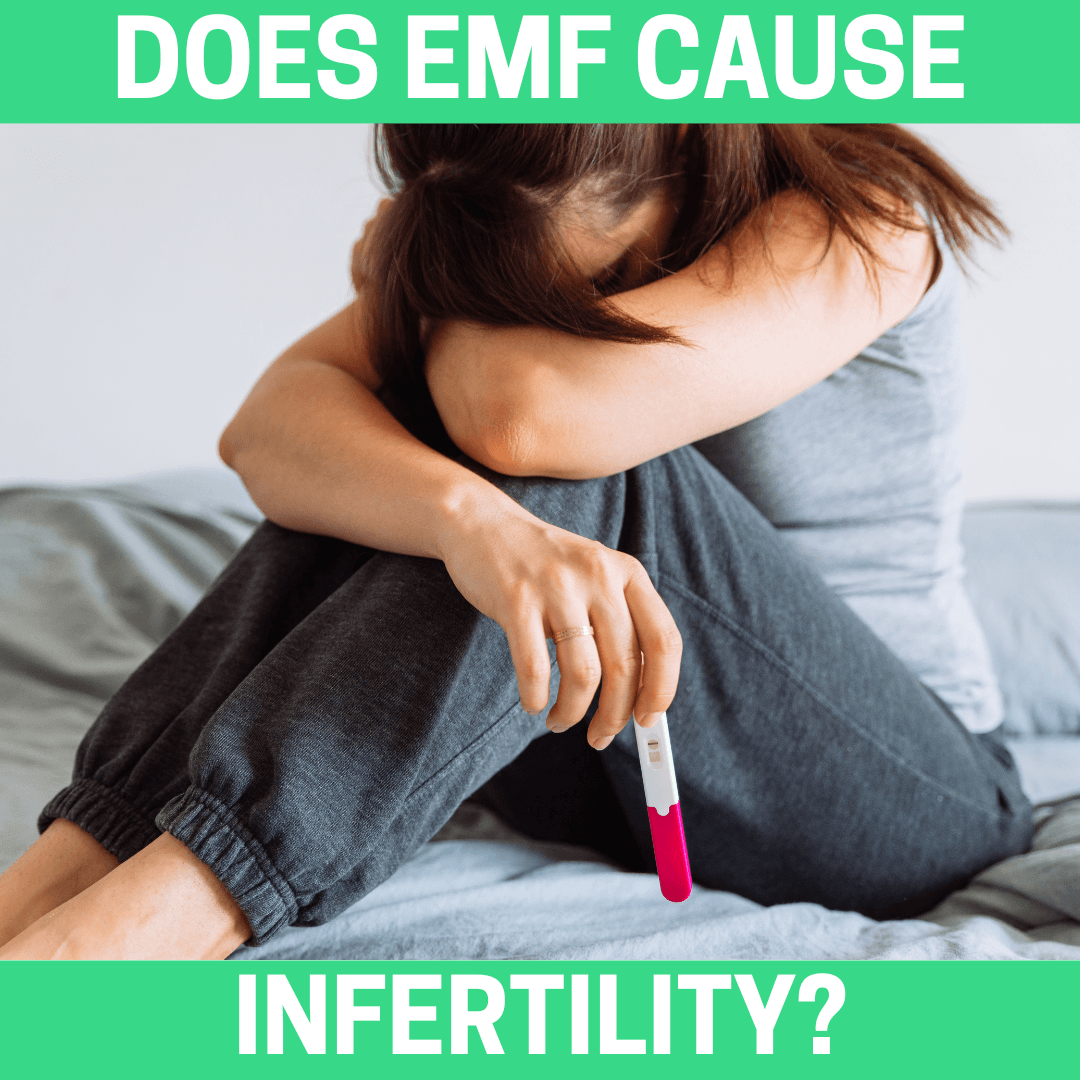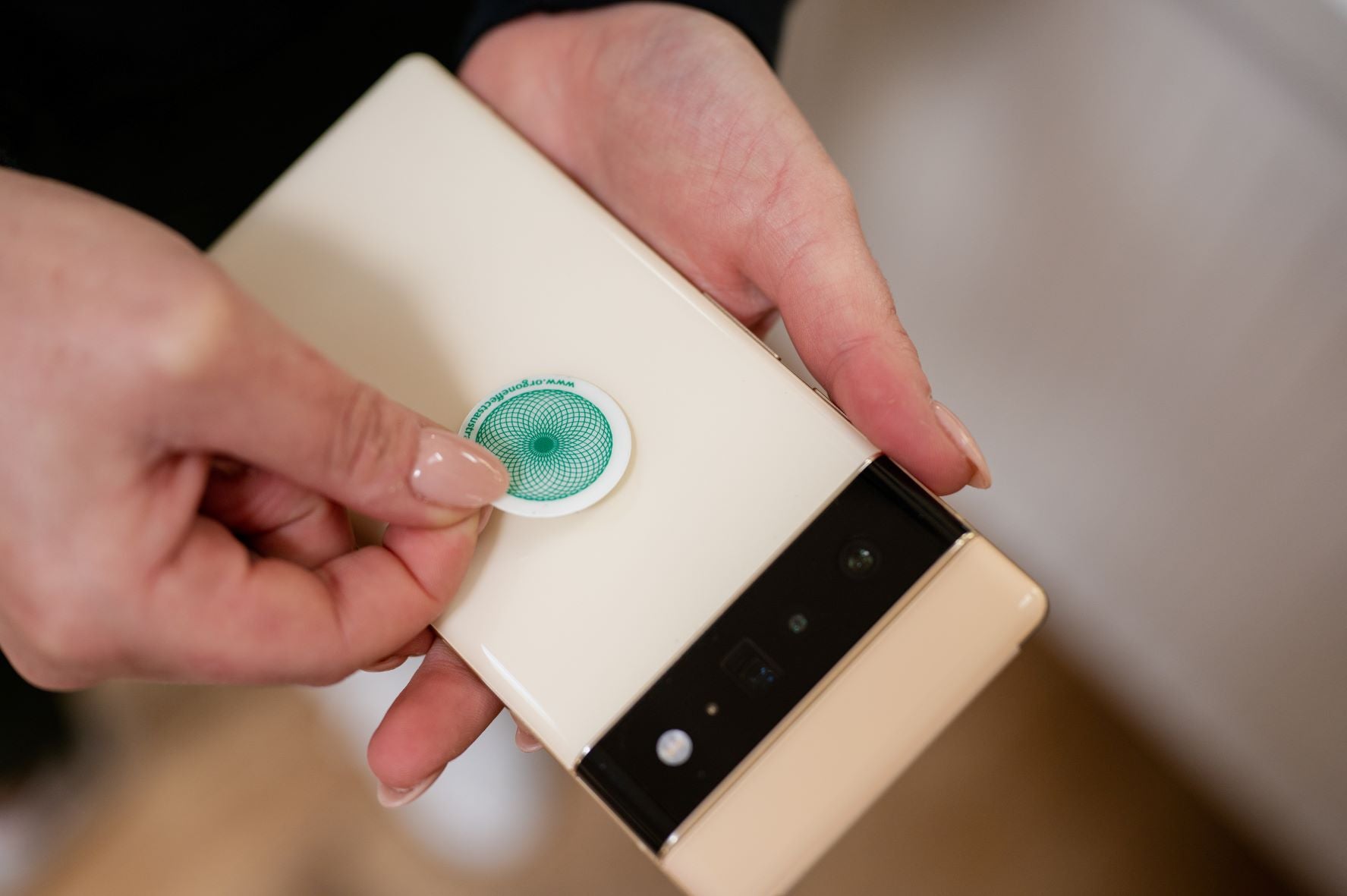Do you have issues sleeping, experience headaches or fatigue? You may be suffering from EMF radiation disease and not even know it.
What is EMF Radiation Disease?
EMF radiation disease, also known as electromagnetic hypersensitivity (EHS), is a condition characterized by the development of symptoms when exposed to electromagnetic fields (EMFs).
The number of people affected by this condition varies widely between countries and the agency completing the survey. While some estimate only a few people per million, others estimates are much higher.
According to the World Health Organization, those in Scandinavian countries tend to report much higher numbers of EMF radiation disease, most likely because this condition tends to affect the skin in this region.
What Are EMFs?

EMFs are the invisible energy waves emitted by various electrical devices and wireless communication technologies such as mobile phones, Wi-Fi routers, and power lines.
While the scientific community is divided on the existence and causality of this condition, individuals who report EHS experience a range of symptoms including headaches, fatigue, sleep disturbances, and dizziness.
While these symptoms may seem mild, they can be debilitating for many individuals. Unfortunatly, there are many studies that indicated EMF exposure may be linked to many serious health conditions.
EMF and Cancer

While many health care organizations claim there is no correlation between EMF exposure and cancer, many studies contradict that information.
One study in particular called for stricter regualtions on EMF exposure levels, particularly for children, who are more vulnerable to the effects of EMF exposure.
While many 'experts' claiim biological effects do not occur at low-intensity electromagnetic fields (EMFs) exposure, there are many studies that contradict that information.
Certain health issues associated with ELF and/or RF are:
- Childhood leukaemia
- Brain tumours
- Genotoxic effects
- Neurological effects
- Neurodegenerative diseases
- Immune system deregulation
- Allergic and inflammatory responses
- Breast cancer
- Miscarriage
- Cardiovascular effects
Overview of Health Effects Associated with EMF Exposure
Exposure to electromagnetic fields (EMFs) emitted from various sources, such as mobile phones and electronic devices, can have several health effects on individuals.
One of the immediate health concerns associated with high levels of EMF exposure is Acute Radiation Syndrome (ARS). ARS can lead to symptoms like nausea, vomiting, skin burns, and even death in extreme cases.
Additionally, EMF exposure has been linked to oxidative damage in the body. This refers to an imbalance between the production of free radicals and the body's ability to counteract their harmful effects.
Oxidative damage has been associated with various health conditions, including neurodegenerative diseases and cardiovascular disorders.
Studies have also indicated a potential link between EMF exposure and fertility complications.
Research suggests that frequent exposure to EMFs can decrease sperm quality and motility, leading to reduced fertility in men.
Pregnant women exposed to high levels of EMFs may face an increased risk of miscarriage and adverse developmental effects on the fetus.
Moreover, long-term exposure to EMFs has raised concerns about an increased risk of cancer. While the evidence is still inconclusive, several studies have reported associations between EMF exposure and certain types of cancers, including brain cancer and leukemia.
Prolonged EMF exposure has been associated with a range of health effects, including acute radiation syndrome, oxidative damage, fertility complications, potential harm to developing fetuses, and an increased risk of cancer.
It is essential to further explore the potential health risks and take precautions to minimize unnecessary EMF exposure.
Potential Causes of EMF Radiation Disease
EMF Radiation Disease refers to the potential health effects caused by exposure to electromagnetic fields (EMFs).
The mechanisms by which EMFs affect cellular communication and contribute to this disease are still being researched. One potential cause is the disruption of voltage-gated calcium channels (VGCC) in the body.
VGCCs play a crucial role in regulating the entry of calcium ions into cells, which is essential for cellular functions.
Studies have shown that exposure to EMFs can lead to the activation of VGCCs, causing an influx of calcium ions.
This disruption in calcium homeostasis can have various detrimental effects on the body.
One of the potential consequences of VGCC disruption is heart rate changes.
EMF exposure has been associated with alterations in heart rate variability, which can affect cardiovascular health.
Additionally, VGCC activation in the brain may contribute to cognitive impairment, as calcium signaling is involved in neuronal processes.
EMF Radiation Disease may also result from DNA damage. Increased calcium levels due to VGCC activation can induce oxidative stress and DNA strand breaks.
This can potentially lead to genetic mutations and play a role in the development of various health conditions.
Furthermore, altered protein expression is another possible cause of EMF Radiation Disease.
Calcium influx resulting from VGCC activation can impact protein synthesis and function, potentially leading to cellular dysfunction and adverse health effects.
EMF Sensitivity From Prolonged Exposure
It is important to note that electrosensitivity, which refers to individuals who experience symptoms in response to EMFs, may also be linked to cumulative EMF exposure over time.
This condition is characterized by subjective symptoms, such as headaches, fatigue, and sleep disturbances, and further research is needed to fully understand its mechanisms.
EMF Radiation Disease may be caused by the disruption of cellular communication, including VGCC activation, leading to heart rate changes, cognitive impairment, DNA damage, and altered protein expression.
Understanding these potential causes is crucial in identifying strategies for mitigating the adverse health effects associated with EMF exposure.
Types and Sources of EMF Exposure
Electromagnetic fields (EMFs) are a form of non-ionizing radiation that are generated by various sources in our environment.
There are two main types of EMF: electric fields and magnetic fields. Electric fields are produced by the voltage in electrical systems, while magnetic fields are produced by the flow of electric current.
Common sources of EMF exposure include household appliances, electronic devices, power lines, cell phones, and wireless devices.
These devices emit electromagnetic radiation, which can have potential health effects on human beings.
It is important to understand the types and sources of EMF exposure in order to assess and minimize possible risks to our overall health and well-being.
High-Voltage Power Lines

High-voltage power lines, which transmit electricity from power plants to substations and distribution centers, have been a subject of concern due to their potential health risks.
The primary health risk associated with high-voltage power lines is the exposure to low-frequency electromagnetic fields (EMFs). EMFs are produced by the flow of electric current and are classified as a type of non-ionizing radiation.
Exposure to low-frequency EMFs can occur both inside and outside the home. Inside the home, common sources of low-frequency EMF exposure include electrical appliances such as refrigerators, washing machines, and televisions.
Outside the home, the main source of low-frequency EMF exposure is high-voltage power lines.
How Strong are EMFs From Power Lines?
The strength of electromagnetic fields near power lines, transformers, and electricity substations depends on several factors.
- The voltage and current carried by the power line
- The distance from the source of the EMF
- The configuration of the power system
Generally, the closer one is to a power line or substation, the higher the exposure levels will be.
While research on the health effects of EMF exposure is ongoing, some studies have suggested a possible link between long-term exposure to high-voltage power lines and certain health conditions, such as childhood leukemia and certain cancers.
High-voltage power lines pose potential health risks due to exposure to low-frequency EMFs.
The primary sources of low-frequency EMF exposure are electrical appliances inside the home and the power lines themselves outside the home. The strength of the EMFs near power lines, transformers, and substations depends on various factors. Further research is needed to fully understand the potential health effects of high-voltage power lines and EMF exposure.
Wireless Devices

Exposure to wireless devices, such as cell phones and other devices that use radiofrequency (RF) energy, has raised concerns about potential health risks.
While research in this area is ongoing, some studies suggest that long-term use of wireless devices may be associated with certain health conditions, including brain tumors, acoustic neuromas, and infertility in men.
To ensure safe human exposure to RF energy, the Federal Communications Commission (FCC) has established guidelines and limits.
The Specific Absorption Rate (SAR) is a measure of the rate at which RF energy is absorbed by the body. The FCC has set a SAR limit for wireless devices to ensure that the energy absorbed by the body is within safe levels.
Check out: How to Measure SAR
To find the SAR value for a specific phone, you can use the FCC ID Search database. Follow these steps:
- Locate the FCC ID on your phone. It is usually found in the phone's settings, under "About Phone" or "General Information."
- Go to the FCC ID Search website (https://fccid.io/).
- Enter the FCC ID in the search bar and click on the search button.
- Look for the SAR value in the search results. It will be listed under the "Product Details" section.
It is important to note that the SAR value is a measure of the maximum energy absorbed under laboratory conditions and may not reflect actual usage. However, choosing wireless devices with lower SAR values can help reduce your exposure to RF energy.
While the potential health risks associated with wireless devices are still being studied, following the FCC guidelines and being mindful of SAR values can help minimize exposure to RF energy.
Cell Phones/Mobile Phones
Cell phones, also known as mobile phones, have become an integral part of our lives. However, they are not without their health risks.
One of the primary concerns of cell phones use is the potential increased risk of brain tumors among heavy mobile phone users.
Research conducted by the International Agency for Research on Cancer (IARC) has classified mobile phone use as "possibly carcinogenic."
This classification is based on limited evidence that suggests a possible link between long-term, heavy cell phone use and the development of brain tumors.
While no definitive link between these effects and resulting health effects has been established, studies have observed certain biological effects in both humans and animals.
For instance, alterations in sleep patterns have been reported among individuals exposed to cell phone radiation, although the causal relationship is not yet clear.
Similarly, studies in male animals have shown a potential impact on fertility, while cognitive performance in humans has also been found to be influenced by mobile phone use.
It is advisable to take precautionary measures such as using hands-free devices, limiting the duration of calls, and keeping the phone away from the body when not in use.
Of course, many of us would now consider ourselves 'heavy cell phone users' and are unable to put a safe distance between us and our phones for the majority of the day.
Forunately, at Orgone Energy we offer many solutions to help shield your body from the potentially negative RF radiation.
Phone Computer Bluetooth WiFi Radiation Protection
Reduce EMF radiation with our Phone Computer Bluetooth WiFi Radiation Protection. This all-in-one EMF protection sticker blocks up to 95% of harmful radiation. Stay safe with your devices.
Shungite Plate for Cell Phone

Protect yourself with the Shungite Plate for Cell Phone. Crafted from natural minerals, this plate effectively blocks up to 99% of EMFs, ensuring your well-being while staying connected. Experience tranquility thanks to this uncomplicated, shielding solution.
Health Risks Associated with EMF Exposure

Exposure to electromagnetic fields (EMF) has become a growing concern due to the widespread use of electronic devices and wireless technologies.
The potential health risks associated with EMF exposure have been a topic of debate and scientific investigation.
While non-ionizing radiation, which includes EMF, is generally considered safe at low levels, there are concerns about the long-term effects of prolonged and high-level exposure.
Various studies have explored the possible adverse health effects of EMF exposure, including the risk of cancer, sleep disturbances, and electromagnetic hypersensitivity.
As our dependency on electronic devices and wireless technologies continues to increase, understanding the potential health risks of EMF exposure is essential for informed decision-making and the development of appropriate safety guidelines.
Sleep Disturbances & Environmental Intolerance Syndrome (EIS)

EMF exposure has been linked to sleep disturbances and the onset of Environmental Intolerance Syndrome (EIS).
Sleep disturbances, such as difficulty falling asleep, frequent waking during the night, and overall poor sleep quality, have been reported by individuals who are exposed to high levels of electromagnetic fields (EMFs) from sources such as electronic devices, wireless networks, and high-voltage power lines.
One key factor contributing to sleep disturbances is the blue light emitted by electronic devices.
Blue light can suppress the production of melatonin, a hormone that regulates sleep-wake cycles. When exposed to blue light close to bedtime, the body's natural production of melatonin is disrupted, leading to difficulty in falling asleep and maintaining a restful sleep throughout the night.
Furthermore, individuals with Environmental Intolerance Syndrome (EIS), also known as electromagnetic hypersensitivity or electrohypersensitivity, often experience a range of non-specific health problems.
These symptoms can include headaches, body pain, lethargy, tinnitus, nausea, and anxiety.
EHS individuals often report these symptoms after exposure to electromagnetic radiation, and their severity can vary among individuals.
It is important to be aware of the potential impact that EMF exposure and blue light from electronic devices can have on sleep and overall health.
Implementing measures to reduce EMF exposure, such as keeping electronic devices away from the bedroom and using blue-light-blocking filters, can help promote better sleep and mitigate the symptoms associated with EIS.
Increased Risk of Cancer & Adverse Health Effects

Exposure to electromagnetic fields (EMFs) has been a subject of concern due to its potential association with an increased risk of cancer and adverse health effects.
While EMFs are classified as non-ionizing radiation, which means they do not have enough energy to directly damage DNA, studies have suggested a potential link between EMF exposure and the development of certain types of cancer.
Although the mechanism by which EMFs may promote cancer development is not fully understood, research has shown an increased risk of leukemia in children exposed to high levels of magnetic fields, particularly those living near high-voltage power lines.
Additionally, studies have reported a possible association between EMF exposure and an increased risk of brain tumors and breast cancer.
In addition to the potential risk of cancer, prolonged or excessive exposure to EMFs can have adverse health effects on various systems in the body.
These effects can include physiological changes, such as alterations in cell function and metabolism, as well as subjective symptoms like headaches, fatigue, and sleep disturbances.
It should be noted, however, that the scientific community is still working to fully understand the impact of EMFs on human health.
In conclusion, while the increased risk of cancer and adverse health effects associated with EMF exposure is still a subject of ongoing research, it is important to be aware of potential risks and take necessary precautions.
Understanding the current scientific understanding of EMF exposure and following recommended guidelines can help mitigate potential harms and promote overall well-being.









